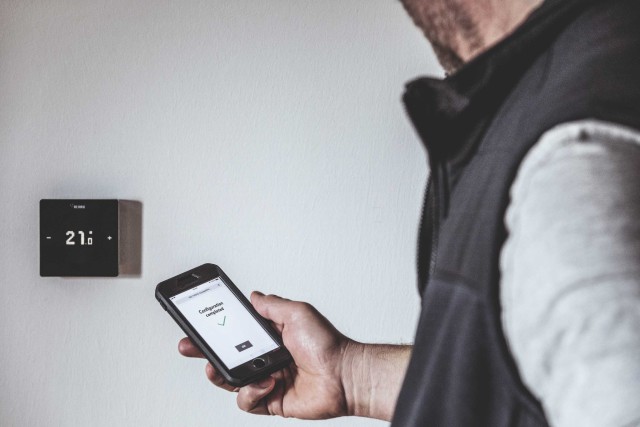Realising sustainable demand through smart temperature control

With building sector emissions posing a major challenge to meeting climate commitments, contractors must consider efficient solutions that both reduce energy demand and keep occupant welfare in mind. Franz Huelle, Head of Technical at REHAU Building Solutions, discusses the potential for smart controls to ensure energy efficiency without compromising the end-user experience.
A national target of achieving a 78% reduction in carbon emissions by 2035 compared to 1990 levels stands as a key enabler for the green transition that was laid down in the Government’s Sixth Carbon Budget. Taken alongside stats from the Climate Change Committee’s (CCC) 2022 Progress Report to Parliament 1 stating that the building sector contributed to 20% of total UK emissions in 2021, this is clearly an area where progress is paramount for decarbonisation. More specifically, heating is a major source of building emissions that must become more efficient in practice to reduce energy demand and drive considerable change in the provision of building services.
Patterns of consumption
It is evident that changing patterns of building occupancy have placed greater emphasis on energy consumption in residential dwellings. The emergence of remote working due to the pandemic, has contributed to increasing emissions from homes. According to the CCC’s latest report, residential buildings account for 80% of the total emissions from the built environment, rising 7.7% from 2020 to 2021 due to working-from-home arrangements. Despite falling 4.7% from 2021 to 2022, this figure remains above pre-2019 levels. With this in mind, working from home has the potential to make reducing energy demand an increasingly difficult task.
This is not to say that commercial buildings can be overlooked. As such sites tend to be larger by their very nature, they typically produce more carbon emissions, and can be more susceptible to inefficient practice. Despite the rise of hybrid working, the CCC has also revealed that there has been no significant change in energy intensity in office buildings since 2014. As such, energy use needs to evolve dramatically across the building construction as a whole, and optimising utility provision is a key part of this.
User experience
At the same time, building contractors should bear in mind occupant needs when installing energy-efficient heating solutions. Working from home has increased the need for temperature requirements that are room specific, while soaring energy prices also mean homeowners are more conscious of accurately controlling energy consumption. Indeed, such demand is reflected in the growth of the smart technology market across residential settings, with Statista 2 forecasting UK household penetration of such devices rising from 45.8% in 2022 to 84.8% by 2026.
A similar situation can be seen in commercial buildings. As occupant comfort and safety is integral to any property, operators must also ensure that any installation does not encroach upon these needs. This is particularly pertinent for office environments, where organisations will be determined to avoid any detriment to the productivity of their workforce.
Fan Coil Units
With the above in mind, many landlords have decided to equip their properties with fan coil units (FCUs), which make use of hot and cold water to temper air. Commonly used in conjunction with a ventilation duct system, users are able to regulate the temperature of multiple spaces simultaneously – all while remaining more economical than alternatives such as variable air volume (VAV) systems. FCUs can also be installed and operated without impacting occupant experience, as they can be easily sited in ceiling cavities or the like.
Keeping sight of air quality
When implementing such systems, it must be acknowledged that air quality is a critical factor. Usually, when using any heating and ventilation system, rapid changes between hot and cold can invite a risk of poor air quality – especially in well-insulated spaces such as new builds.
Switching between the two can generate both condensation and humidity, which together create inviting conditions for mould to spawn. While mould can manifest as solely an unsightly nuisance, it can also be a serious health hazard, leading to numerous health problems including headaches, fatigue, sneezing, and dermatitis.

The presence of mould can prove as detrimental to the building and its operation as it is to its occupants, greatly speeding up the deterioration of wallpaper, carpets, ceiling tiles and floorboards. If left to fester, mould can even weaken ceilings and floors to the point of collapse, causing irreparable structural damage.
Moreover, uplifts to Building Regulations only stipulate the importance of indoor air quality. Building contractors working on commercial sites must pay particular notice to changes in Approved Document F which outlines new requirements around air supply and the presence of pollutants.
The power of smart controls
Effective temperature control has the capability to avoid these hazards and help manage indoor air quality in line with regulations. FCUs, for instance, are best operated in conjunction with a smart control system to ensure that any temperature changes occur in a safe and controlled manner.
For example, REHAU’s NEA Smart 2.0 comes equipped with fan coil integration, enabling synergy with any FCUs on site in order to achieve maximum efficiency without compromising air quality. Intelligent algorithms in solutions such as these ensure that any transitions between heating and cooling are gradual without creating unwanted humidity or condensation – the absence of which makes it difficult for mould to grow.
Smart controls also provide the ability to measure air quality and make automatic adjustments based on this. Fitting sensors in walls, ceilings and floors can even allow advanced systems to calculate the dew point of a specific zone, meaning that FCUs can operate at their optimum energy efficiency without posing risks to any wallpaper, flooring or furniture. As underfloor heating control is also included, operators can realise maximum synergy between heating and ventilation systems on-site to ultimately avoid energy wastage.
Intelligent progress
Impending sustainability targets and regulatory pressures have placed an increased burden on contractors to ensure that properties are equipped with energy-efficient features. However, it is vital that these upgrades do not come at the expense of user experience, with poor air quality a leading cause of harmful mould.
Here, smart controls stand as an effective solution, allowing operators to guarantee that air quality is not compromised in pursuit of efficiency. With both modular control of individual zones and performance more in demand than ever, incorporating smart control systems such as our solution should be a priority moving forwards.
1 www.theccc.org.uk/publication/2022-progress-report-to-parliament
2 www.statista.com/outlook/dmo/smart-home/united-kingdom







